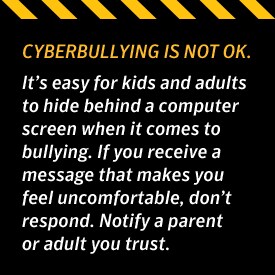What is cyberbullying?
Online socializing has both good and bad sides to it. While it has opened a whole new dimension of ways to communicate and has added convenience to our lifestyles, it unfortunately has some unpleasant effects, too.

Online socializing has good and bad sides to it. While it has opened a whole new dimension of ways to communicate and has added convenience to our lifestyles, it unfortunately has some unpleasant effects, too.

A security suite that helps protect your devices.
Free security software just doesn’t have the resources to keep up with new threats as they emerge. That’s why you need a multi-layered defense to security. Meet Norton Security Premium — protection for up to 10 of your devices.
Cyberbullying is one example that has had devastating outcomes on our youth. It uses online communication to abuse or degrade someone. It’s a crime that doesn’t restrict itself to the playground. With advancements in technology, cyberbullying has gained notoriety over the years.
Unlike bullying, cyberbullying doesn’t require physical strength or a face-to-face meeting. Anyone with an Internet connection and a device can be a cyberbully. There are no specific hours, and it can happen 24/7. Since many platforms don’t make an effort to verify that people are who they say they are, the cyberbully can choose an alias and remain anonymous.
According to a recent survey by Norton by NortonLifeLock, 64% of parents believe their children are more likely to be bullied online than on a playground, which means finding solutions to ending online bullying should be a priority for parents and school officials. In the face of traumatic experiences, the mind of a child can be deeply impacted, and those experiences can leave lifelong scars. Children have difficulty knowing how to respond when they are harassed. And when they do react, they often don’t completely understand the consequences of their actions. Cyberbullying has left many of our youth depressed or withdrawn, and in some cases it has led the victim to commit suicide.
There are many different types of cyberbullying out there. Here is a list of terms that define the different types of cyberbullying:

1. Outing
Outing is a deliberate act to embarrass or publicly humiliate an individual by posting their private, sensitive or embarrassing information online. The information revealed can be insignificant or serious, but can have a severe impact on the victim.
2. Fraping
Fraping is serious offense where a person accesses the victim's social media account and impersonates them in an attempt to be funny or to ruin their reputation. Fraping can have serious consequences, especially because once something is out there, it is very hard to delete it and mend the victim’s digital reputation.
3. Dissing
Dissing is when people share or post cruel information about your child online to ruin their reputation or friendships with others. This includes posting personal photos, videos and screenshots. The person sharing this information will usually be a friend or acquaintance of the victim.
4. Trolling
Trolling is a form of cyberbullying done by insulting an individual online to provoke them enough to get a response. Usually these attacks are personal and instigate anger in the victim, making them lash out and behave badly.
5. Trickery
Trickery is the act of gaining your child’s trust so that they reveal their secrets or embarrassing information, which the cyberbully posts on the Internet for everyone to see. The person pretends to be a close friend and confidant, and gives the child a false sense of security before breaking his/her trust.
One of the first things parents must do when their child is being cyberbullied is stay aware and calm. Children may not like to tell their parents when they are being cyberbullied because they are afraid that they will lose their Internet privileges. Talk to your children about cyberbullying. Let them know cyberbullying can be common. Teach them the basics of online security and stay connected with them daily and digitally.
Another option to keep children safe online is to install reliable online security on all the devices they access. Norton Security Premium lets your kids explore the web freely while keeping you in the know about which sites they visit. It comes with parental controls that block unsuitable content for kids and can give you insight into your child’s social media activity when they log in to social media sites from their PC. The security system also helps protect your child from accidentally giving out sensitive personal information from their computer. This includes phone numbers, address, email and the school they attend. It also alerts you when your child attempts to visit a blocked site.
Cyberbullying, like any other problem, will take time to solve. But when handled calmly, there are solutions available to help manage the problem.
Editorial note: Our articles provide educational information for you. Our offerings may not cover or protect against every type of crime, fraud, or threat we write about. Our goal is to increase awareness about Cyber Safety. Please review complete Terms during enrollment or setup. Remember that no one can prevent all identity theft or cybercrime, and that LifeLock does not monitor all transactions at all businesses. The Norton and LifeLock brands are part of Gen Digital Inc.




Want more?
Follow us for all the latest news, tips and updates.